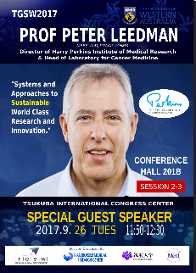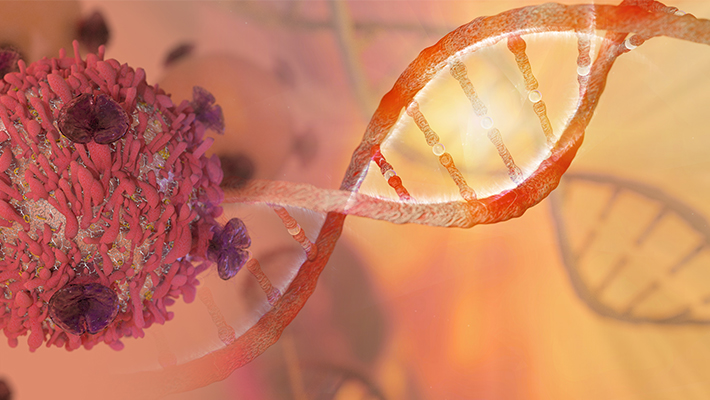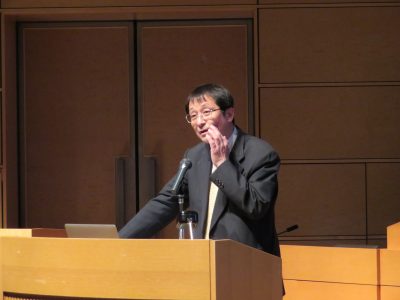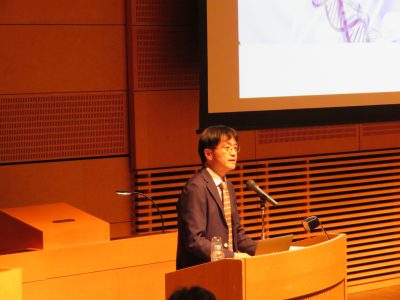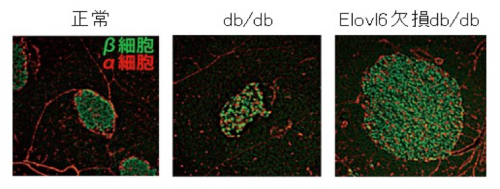MEDIA RELEASE
A delegation from University of Tsukuba, including two members of Transborder Medical Research Center, travelled to Perth, Australia between 5-7th June, 2018 to expand relations with University of Western Australia (UWA) under the international UT Campus-in-Campus initiative.
The successful trip allowed Professors from University of Tsukuba to attend symposium events planned by UWA and the nearby Harry Perkins Institute of Medical Research, and to meet researchers and department members to discuss the potential for expanding collaboration and research opportunities.
The visiting University of Tsukuba delegates included: Professor Teruo Higashi from Global Affairs Office (ex University Vice President); Professor Yasunori Sasakura, Director of Shimoda Marine Research Center, Marine Science; Professor Chiaki Matsukura from Gene Research Center, Plant Science; Associate Professor Masafumi Muratani of Faculty of Medicine’s Transborder Medical Research Center Genome Biology Core and Mr Ian McMullen, also of the Faculty of Medicine’s Transborder Medical Research Center.

Photo: University of Tsukuba delegates meet Harry Perkins Institute of Medical Research representatives in Perth, Western Australia.
The delegation met with Heads of UWA’s International Affairs and Harry Perkins Institute of Medical Research, as well as the WA Oceans Institute, the Department of Plant Sciences and the Department of Sport Science.
The “Perkins” hosted an afternoon symposium and reception dinner, allowing Professors to highlight research capabilities and status of their work.
Japanese visiting Professors from University of Tsukuba were also able to deliver presentations promoting sharing of resources and showcased the high-level of research being conducted at University of Tsukuba. The symposium and casual dinner discussions afterwards offered an excellent opportunity to share knowledge and to discover untapped research collaboration opportunities.
Photo: University of Tsukuba’s Professor Teruo Higashi presents details of University of Tsukuba at the Harry Perkins Institute of Medical Research symposium in Perth, Western Australia.
Strong relationships were forged between Japanese delegates and WA representatives to help continuing relationships between University of Tsukuba, University of Western Australian and Harry Perkins Institute of Medical Research.
The delegation also had various one-on-one meetings and tours to view significant technology facilities for research related to a myriad of ongoing plant, marine and medical related studies within UWA and the Perkins Center. The visit to Perth signaled the beginning of an exciting new phase of collaborative research and education between University of Tsukuba and Harry Perkins Institute of Medical Research.
Photo: University of Tsukuba delegates meet the Oceans Institute at University of Western Australia in Perth, Australia.
Article by: Ian McMullen
Transborder Medical Research Center
Faculty of Medicine, University of Tsukuba, Ibaraki, Japan
2017 Tsukuba Global Science Week - Tsukuba Transborder Medical Research Center presentations
Promotion of Basic Research in Life Science with Exit Strategy
The Transborder Medical Research Center held a sucessful morning of presentations at the 2017 Tsukuba Global Science Week in the International Congress Center, Tsukuba, Japan on 26 Sept, 2017.
The theme of presentation sessions was “Promotion of Basic Research with Exit Strategy”.
Special guest speakers included Professor Peter Leedman of Harry Perkins Institute of Medical Research, Perth, Australia, Professor Akiko Hata from University of California, San Francisco, USA and Professor Toru Natsume of Japan’s National Institute of Advanced Industrial Science and Technology (AIST). Trans-border Medical Research Center members Professor Satoru Takahashi and Dr Chris Hipolito also gave presentations on their recent work.
Discovery of a carcinogenic mechanism causing specific malignant lymphoma.
[Caution: Auto-translated English text unvarified for accuracy]
→ Full Media Release in Japanese (日本語)
A collaborative research group of Professor Shigeru Chiba and Associate Professor Asamiko Sakata of the University of Tsukuba is involved in the binding of an abnormal protein to the VAV1 protein by the mutation of the RHOA gene found in certain malignant lymphomas, which results in T-cell receptor signaling. Was found to be abnormally activated.
Image by CI Photos/Shutterstock
In the present study, we found that the abnormal RHOA protein produced by the G17V RHOA mutation binds to VAV1 protein, which is a molecule that transduces T cell receptor signals, and causes abnormal activation (phosphorylation) of VAV1 protein. It was also found that in some cases without the G17V RHOA mutation, the VAV1 gene was abnormal, and the mechanism that self-suppresses the activation of the VAV1 protein was broken, resulting in abnormal activation. Activation of the VAV1 protein resulted in activation of the T cell receptor signal, which was blocked by tyrosine kinase inhibitors used in other blood cancers.
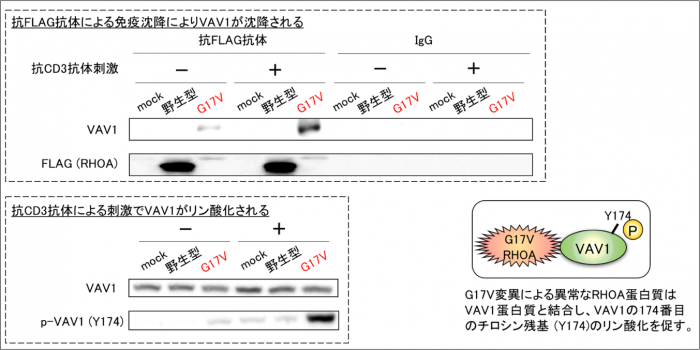
Figure. Abnormal RHOA protein due to G17V mutation bound to VAV1 protein (upper diagram) and was activated (lower left). Bottom right is a summary figure.
Based on the above findings, it is expected that new treatment methods based on specific genomic abnormalities will be created for some of the malignant lymphomas that have been difficult to treat.
2017 Tsukuba Global Science Week - Tsukuba Transborder Medical Research Center presentations
MEDIA RELEASE
TRANSBORDER MEDICAL RESEARCH CENTER HOLDS
INTERNATIONAL SYMPOSIUM IN TSUKUBA, JAPAN
The recently opened Transborder Medical Research Center organized by University of Tsukuba’s Faculty of Medicine, successfully held its first International Symposium at Epochal International Conference Hall in Tsukuba, on Saturday 17th, 2017.
The full day event was well attended and attracted an enthusiastic audience of over 170 people, including VIP guests, National and International clinicians, researchers and students; as well as representatives and experts of industry and business, and members of the general public.
Numerous informative speeches and biomedical research presentations were delivered throughout the four separate sessions of the day. The presentations show-cased the world class capabilities and important ‘cross-field’ collaboration research being conducted within the Transborder Medical Research Center.
The International Symposium was opened by Dr Kyosuke Nagata, President of University of Tsukuba, with remarks emphasizing the importance of building open “transborder” research collaborations across complex and varied fields of research; an aim specifically pursued by the pro-active initiatives of Transborder Medical Research Center.
The symposium organizers and attendees were also honored to have VIP guest speaker Mr Shigechika Terakado, Director of Scientific Research Institutes Division, Research Promotion Bureau (MEXT), offer a highly motivational speech to current and future researchers in Japan, on behalf of the Japanese Government.
It was stated that Japanese researchers should act with a sense of need and urgency in breaking down the barriers between fields of research and communication, as such barriers act to restrict research potential and discovery in science. The requirement for Japan to accelerate research and innovation that benefits and advances global society and economy, cannot be understated.
The wide consensus from the symposium audience was that all presentations given during the day were highly informative and displayed an impressive level of research capability. Of particular note and interest were presentations delivered by invited guest speakers: Dr Seong-Jin Kim from Seoul National University, Dr Peter ten Dijke from Leiden University, Netherlands, Dr Yumiko Oishi of Tokyo Medical Dental University and Dr Tilo Kunath from University of Edinburgh.
“Transborder Medical Research Center is opening up medical science and improving collaboration between important core components of complex research.”, said university President, Dr Nagata. “Transborder Medical Research Center is taking an important step towards advancing potential and opening opportunities for development of innovative research and technology. Not only within the confines of the laboratories in our university, but also locally, nationally and across the globe.”
To assist future sustainability of the center, effort is also being made to identify and encourage research projects and services that “add value” and provide opportunities for applied innovation through clinical trials and real-world advances in biomedical technology.
“By combining the extensive research wisdom and support from highly experienced research Professors, with the excellent work of proven up-and-coming Assistant Professors and researchers in a broad and open cross-field research incubator environment, TMRC can help ensure that Japan maintains an inspired new generation of biomedical researchers. Researchers capable of participating in highest-level, world class research and producing exceptional research results.”, said Professor Satoru Takahashi, Director of Transborder Medical Research Center.
Over the next few years, TMRC will grow to contain three divisions: the “Base Research Division”, the “Integrated Research Division” and later in 2019, “Animal Resources Division”. These three divisions will ultimately contain 11 specific ‘cores’ of high-level research capability. These cores contain important essential research technology and know-how. These components were selected to be part of Transborder Medical Research Center as the likeliest essential elements required to produce important breakthrough research in human disease in future. In the past, these core competencies of research have helped advance understanding in diseases such as cancer, diabetes, metabolic syndrome and a host of other important conditions.
The research cores being strategically built into Transborder Medical Research Center include: Genome Biology, Metabologenomics, Peptide Research, Informatics in the Base Research Division; Cognitive Neuroscience, Infection Biology, Energy Metabolism and Cell Dynamics in the Integrated Research Division; and GM Mouse Resources, Biological Imaging and Experimental Zoology in the Animal Resources Division.
This structure allows TMRC to continually advance research and organization of collaboration. By intimately sharing latest important research know-how and results between associated labs and divisions, greater collaboration and discovery at the cutting edge of Medical Science research will be achieved. In turn, this allows an even greater pace of discovery and will lead to creation of entirely new and innovative fields of medical technology and academic study in future.
筑波大学 医学医療系 島野仁教授、松坂賢准教授らの研究グループは、肥満にともなう糖尿病の発症に脂肪酸伸長酵素Elovl6を介した脂肪酸バランスの変化が関与していることを発見し、Elovl6を阻害することで脂肪酸バランスを改善し、糖尿病の発症を抑制できることを明らかにしました。
肥満にともなう脂肪酸代謝の異常や臓器における脂肪酸の過剰蓄積が、糖尿病を引き起こすことはすでに知られていましたが、脂肪酸の質(種類や組成)の異常の意義は十分に解明されていませんでした。本研究グループは、パルミチン酸(C16:0)からステアリン酸(C18:0)への伸長を触媒する酵素Elovl6に着目し、糖尿病モデルマウスでこの酵素を欠損させると、インスリンを産生する膵臓のβ細胞の量とインスリン分泌が増加し、糖尿病の発症・進展が抑制されることを明らかにしました。本研究成果から、Elovl6の阻害や脂肪酸バランスの管理が、糖尿病の治療標的として有用であると考えられます。
図 正常マウス(左)、db/dbマウス(中央)、Elovl6欠損db/dbマウス(右)の膵臓ランゲルハンス島の免疫染色像。db/dbマウスに比べてElovl6欠損db/dbマウスの膵臓ランゲルハンス島ではインスリンを合成・分泌するβ細胞(緑)の量が増加している。
→ Diabetes 2017 Apr; db161277. https://doi.org/10.2337/db16-1277 (英語/English)
→ PDF資料はこちら(日本語)




